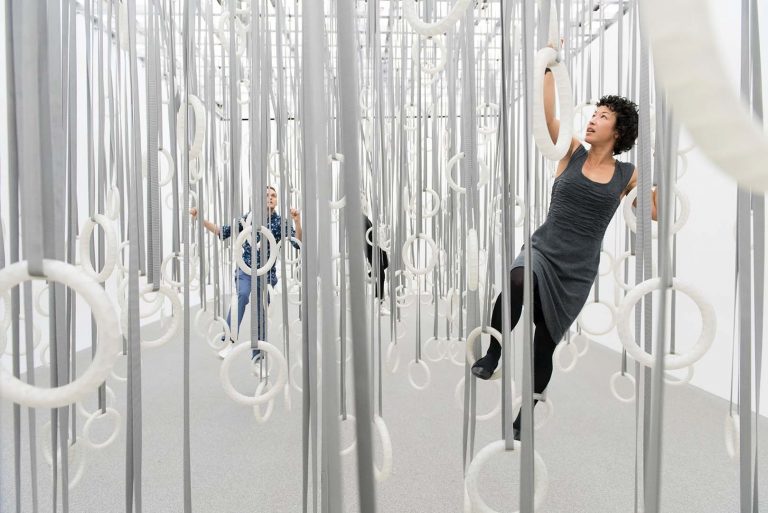We acknowledge the Traditional Owners of the land on which the Queensland Art Gallery | Gallery of Modern Art stands and recognise the creative contribution First Australians make to the art and culture of this country.

William Forsythe / United States b.1949 / The Fact of Matter 2009 / Polycarbonate rings, polyester belts, and steel rigging / Dimensions variable / © William Forsythe and Gagosian Gallery, New York / Courtesy: The artist, Gagosian Gallery, New York, and Forsythe Productions, Berlin
William ForsytheThe Fact of Matter 2008
Not Currently on Display
The Fact of Matter 2009 belongs to William Forsythe’s series of ‘choreographic objects’, through which he explores processes of action-based knowledge by encouraging interaction and movement.
The work is comprised of dozens of gymnastic rings suspended from the ceiling at various heights. The artist asks visitors to traverse the space using only the rings. As participants attempt to fulfil this request, they become aware of their own physical capabilities and limitations, and the inevitability and productivity of failure. Even by simply imagining how to approach the challenge posed by Forsythe, by observing and evaluating why one person succeeded where another failed, there is the potential to learn.
The Fact of Matter serves as a reminder that once programmed into our bodies, our patterns of movement are very often taken for granted. The ‘matter’ of our body has evolved and adapted over time to navigate very particular conditions. However, by challenging us to explore and move in different ways, Forsythe in turn opens the way for new ways of thinking and problem-solving through the body.
William Forsythe is an American choreographer, dancer and artist. Alongside his successful stage productions, Forsythe developed a body of work that he describes as ‘choreographic objects’. These installations and objects blur the lines between performance, sculpture and installation, and extend the artist’s exploration of the role of the body in choreography.
Forsythe invites the audience to move and interact with his works and by doing so, engage with the fundamental principles of choreography. Visitors might be ‘choreographed’ by an object or installation, or offered a challenge, through which they become more aware of their own and others’ movements. Underlying much of Forsythe’s practice is an interest in heuristics, in particular, learning through trial and error. Many his requested actions are difficult, and even impossible, to complete.
Discussion
1. Think about activities such as dance and sport where specific movements are involved. How does this artwork challenge regular patterns of movement?
2. The Fact of Matter is essentially colourless; however, this changes when people enter the space. What impact do you think the addition of colour would have on the work?
3. How would you interpret The Fact of Matter in relation to water?
4. Forsythe is interested in the processes of action-based knowledge. In small groups, discuss what you learned after either participating in the work or through your observations of others.
Activities
1. Create a sculpture comprised of suspended rings. Photograph your work, experimenting with water to achieve different effects.
2. Take photographs of students playing at lunchtime. Use these images to develop a single-colour relief print that emphasises the element of line and the use of positive and negative space. When printing, repeat the image on the same surface to create a pattern.
3. In groups, design an obstacle course comprised of three challenges that require teamwork to complete. At the end of the course, reflect on what you learnt about problem-solving and working in a team.